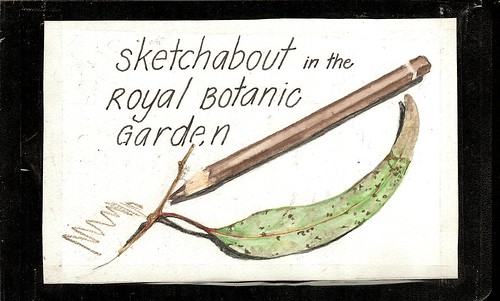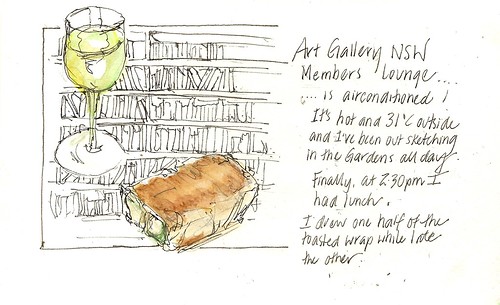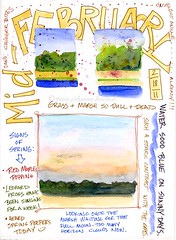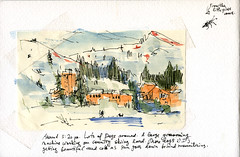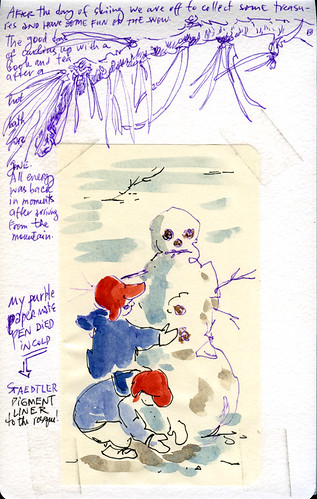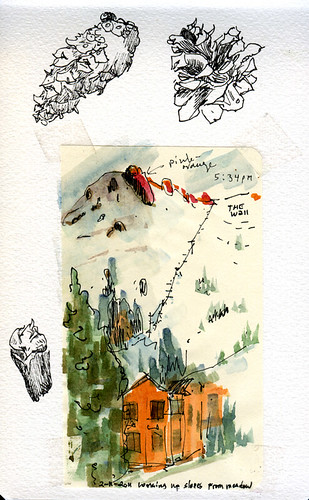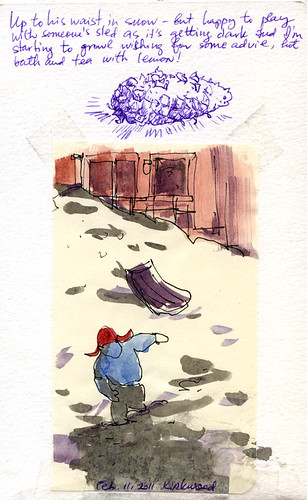Left: Brush pen sketch (Pentel Pocket Brush Pen) on a prepainted background page (acrylics) with gouache for the figure details. Image ©Roz Stendahl. Click on the image to view an enlargement.
Often, when people see my journals they ask, "Why do you use gouache?" And I have a double reply: 1. many of the papers I work on are toned or prepainted and gouache is a perfect medium for those surfaces; and 2. it's fun.
Let's face it, the second reason is the driving force for my use of gouache. Sometimes I just can't go to bed at night until I paint a little with gouache because it's just so much fun, I just want to push the paint around.
You can go to my blog,
Roz Wound Up, and click on the "gouache" category in the category list and find many posts on various aspects of gouache.
Getting people to use gouache is one of my goals in life (just as getting people to make their own journals and getting people to actually keep visual journals are life goals for me).
But there's so much writing about gouache on my blog that I thought I'd give you a little primer on what I love about it—to try and get you hooked.
There's the
fun factor of using gouache.
If you go to this link you'll actually see a close up of the image at the end of the post and then you can see all sorts of details, just as if you had your nose right in my journal. Go peek now. Doesn't that look like the most fun ever! Paint on paint. Sure you can do this stuff with oils, but there are all the smells. Acrylics, same thing—and the speedy drying time and danger of mess if you are out in public.
For me using Schmincke's gouache or M. Graham's gouache allows me to have all the fun of transparent watercolors (because they both wash out into lovely clear washes) and the fun of opaque passages where I can push the paint around if I'm so inclined.
Look for a moment at how you can use gouache with toned paper. If you go to
"Sketching and Collage from the Page Up," and scroll down into the post you'll see the toned paper which has first been painted with acrylics, then the pen sketch, and of course the finished piece which has thick and light applications of gouache. I like to be able to do all of these things when I paint.
Why limit myself! It is fun to use gouache in part because the possibilities are so wide open.
There's also the paint economy issue. If you put out a little too much paint one night unlike your acrylic paints, you can still use the paint the next day. I have an example of using up old paint coming up this Wednesday on my blog, but you can see a previous example in
"Practice Before Bed."
(Note: If you use Schmincke and M. Graham brands of gouache your ability to rewet paint that has dried on your palette is going to be very simple. That said, I often use cheaper and chalkier gouache brands in the studio and then use those dried paints the next day because I'm not looking for a fresh experience, but just some fun. If you want the most workability from your paints I recommend you stick with Schmincke or M. Graham brands of gouache.)
There is something to be said for making a perfect wash in watercolor, for making the stroke of transparent watercolor that totally tells the story you wish to convey. There are masters of watercolor who do that constantly. I love looking at their work.
Then there are those of use who tend to fuss.
Yep, I fuss. Though it is another of my lifetime goals to stop fussing and I get better every year—with a major setback now and then.
If you are someone who fusses then gouache is the paint for you!
One of my landscape painter heroes is
Thomas Paquette. I was amazed to hear that he reworks and reworks his small gouache paintings. They look so fresh and wonderful. (His level of fussing can only be called finesse, and become a level to which we can all aspire.)
So whether you fuss or finesse, gouache is a paint that again, lets you have it all.
There is also something about the texture of a finished painting that speaks to me, regardless of medium. And for gouache, the ability to have a blending of techniques and textures is just too appealing to forego.
The type of texture and detail you get will depend on the brand of paint you select and your working method. Chalky opaque brands (which I don't use in the field because they don't rewet well from the homemade pans with which I travel) give a hard edged and often jarring texture to things that I love, like the dog in
"Details, Play, and Old Gouache."
With the two quality brands that I use,
Schmincke (the link is to the online store I buy it at as it isn't available locally) and M. Graham (do a Google search to find local availability), I find that I get wonderful color blending and mixing and detail. They become my go-to paints for my detailed paintings of birds and rocks. You can see
one of my gouache rocks here.
Fine strokes, blends, it's all possible with this paint.
Here's what you need to do. Pick a brand. I recommend either Schmincke or M. Graham for beginners in this medium— M. Graham if you are cost conscious. Neither of these brands has opacifiers in their paint and your color mixing is going to be more satisfying and less frustrating. You'll loose a little smidge in the opacity department, but you'll be able to work around that with some paint handling skills.
(The other brands of paint tend to yield muddy mixes because of the opacifers and the use of more multi-pigment paints. Years ago I used Winsor and Newton gouache and found the pigments were fugitive and the paint chalky. I needed a paint I could fill pans with and with which I could travel. Recent ads for this product claim that they no longer have opacifiers in their paint so the quality maybe improved, but I would be sure you get the new stock that is improved; and I would also caution you to check up on the pigment quality used in each tube you want.)
Once you have your paints (you can go here to see
my travel palettes and you can go here
to read about my limited palette for gouache) you need to get your brushes dirty and mix some paints and learn how the paint works. (If you are really cost conscious when getting into a new medium don't sweat it—get a red, yellow, and blue, and zinc white to start.)
(A note about brush selection: you can use any watercolor brush and most acrylic brushes for gouache with great success. I recommend that you select quality synthetic brushes to practice with rather than grind a pricey sable brush into the ground. I keep my transparent watercolor brushes separate from gouache brushes because I don't want to worry any transparent washes with the introduction of heavy—more coarsely ground—pigments inadvertently left in a brush. But that's me fussing again. You can read about the brushes I use and why at Roz Wound Up.)
I recommend that you begin with dilution tests. Put some paint out on your palette and with a clean brush drag a bit to an area and mix it to the consistency of thick cream and start brushing that around on your paper.
Oh, and do your exercises on watercolor paper you normally would work on or use Arches watercolor paper. Now is not the time to experiment with paper. I also recommend a cold press paper so that you have some texture, but not so much texture in the paper that you struggle with brush loading issues. Hot press paper is another great way to practice, but you don't immediately get to see all the fun textures that simply dragging a dry brush across paper will yield.
Watch how you load the brush. If you have to add more water to the brush it will make the paint too liquid, but at some point you have to do this so experiment with drawing off the excess water in your brush by touching the base of the brush, near the ferrule, with a paper towel and drawing that water out, leaving most of the pigment. Now do some more stroking.
After a couple hours of playing in this way with your paint you'll start to get an idea of how much paint to water you need for the type of stroke you want to make. It depends in part of the type of brush you're using and the brand of paint you're using.
Whether you're using rounds or filberts (one of my favorite brushes to use with gouache) will also make a difference in how the paint handles. With filberts you have a curved, flat edge that pulls the paint along. Quite a thrill.
Once you have a sense of how to make everything from a dry brush stroke (in which you simply touch your pile of squeezed out paint with a moist brush, i.e., one that was wet and squeezed dry), to wet washes as you would in watercolor you can start mixing your colors to see how they blend.
You'll want to try palette mixing as you do with watercolor, but the most fun will be to paint an area of color and let it dry (or nearly dry) and then paint another color next to it or on top of it and blend the two.
Again, this exercise will require that you learn how to control the water in your brush. I recommend that you work with a moist brush as described above—wet brush squeezed dry in your towel. Then add more water to the brush as needed until you get the blending desired.
One of the most fun things to do is put a second color over a layer of color and make dry-brush strokes of that second color. The broken color gives a great texture effect.
Equally fun is to work with a fresh, undiluted color picked up on a fairly dry brush, and blend that color into a wet or moist color passage already on your paper. YUM!
Do all of these things on a test sheet divided into squares. You'll find where your strengths lie, which approaches need more work, and also you'll discover which textures of this paint you cannot live without.
Why? because in doing these tests you'll get a sense of the paint on your brush and you'll be hooked.
You'll be staying up late into the night just so you can make swirls of thick paint seamlessly meld into other swirls of paint. Just feeling the push of the paint on the brush will make you fell purposeful!
Now that I've got you hooked and you have an opaque paint that is portable (in a way acrylic isn't really) and you're having all this fun, please take a moment
to participate in Project 640 Tubes.
You guessed it, it's another of my life goals—the campaign for PB60 in the M. Graham line.
Roz Stendahl











